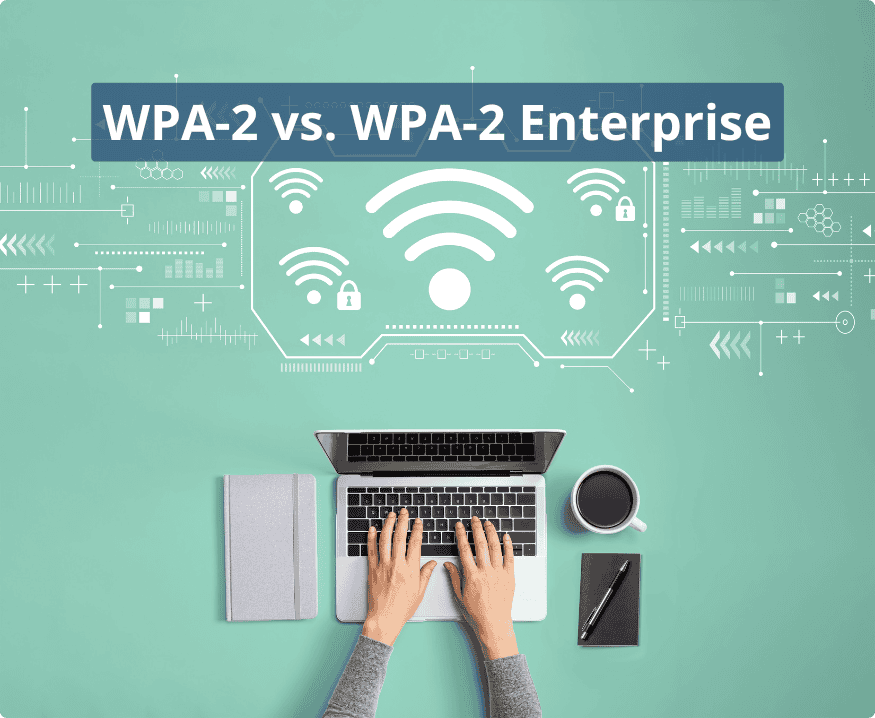WPA-2 vs. WPA-2 Enterprise
Why Multi-Tenant Workspaces Need Stronger WiFi Security

Table of Contents
As flexible, multi-tenant workspaces grow in popularity, so do the security challenges that come with them. In the past, securing a building’s network was relatively straightforward—each tenant had its own isolated network infrastructure. However, in a modern, shared workspace environment, tenants often share WiFi networks, making robust security measures critical.
One of the biggest risks in these environments is unsecured or inadequately secured WiFi, which can provide a gateway for bad actors to exploit vulnerabilities. Enter WPA-2 (WiFi Protected Access 2) and its more secure sibling, WPA-2 Enterprise.
Why WPA-2 Alone Isn’t Enough
WPA-2, the standard for most home and small office WiFi networks, provides basic encryption, but it’s not enough for shared, multi-tenant environments. In a workspace where multiple companies rely on the same network, you can’t just secure at the network level; you need to secure access for every user and every device. WPA-2 doesn’t do that well enough.
That’s where WPA-2 Enterprise comes in. This protocol adds a layer of user authentication, ensuring that only authorized users—and devices—can access the network. In a multi-tenant workspace, where dozens of companies may be using the same WiFi, this level of security isn’t just a best practice—it’s a necessity.
Let’s break down how WPA-2 compares with WPA-2 Enterprise and why the latter is a far better option for environments like shared workspaces.
WPA-2 vs. WPA-2 Enterprise: Key Differences
| WPA-2 | WPA-2 Enterprise | |
| Authentication method | Pre-shared key (PSK) | 802.1x with RADIUS server |
| User control | Same password for all users | Individual credentials per user + allows certificate-based authentication |
| Scalability | Difficult to manage for large groups | Easily scalable for many users |
| Security level | Vulnerable to password sharing & weak keys | Higher security with unique user authentication |
| Device control | Hard to track or control device access | Individual device access can be controlled |
| Ideal use case | Home or small offices (single-tenant) | Multi-tenant workspaces, large organisations |
Why WPA-2 Enterprise Is Essential for Multi-Tenant Workspaces
- Authentication and Access Control
WPA-2 Enterprise provides individual user credentials which means each tenant in the workspace has their own unique login. This is in stark contrast to WPA-2’s shared password, where every user on the network relies on the same key—making it easy for a disgruntled employee or external party to compromise the network once that key is shared. It’s possible to deliver unique usernames & passwords on basic WPA-2 using solutions like Captive Portal or MAC Authentication – however, these still have their security vulnerabilities (for example: MAC addresses can easily be spoofed). WPA-2 Enterprise provides a more robust security solution as it uses 802.1x & RADIUS.
On top of this, WPA-2 Enterprise allows for certificate-based authentication to be used, where – after initial authentication – usernames and passwords are replaced with a cryptographic key (a digital certificate) stored on a user’s device. This approach is much more secure than using passwords which can easily be compromised.
- Scalability and Flexibility
Managing a growing tenant base becomes far simpler with WPA-2 Enterprise. Adding or removing users from the network is straightforward because credentials are unique to each user, and a centralized RADIUS server handles authentication. In contrast, with WPA-2, changing the network password would mean disrupting every tenant in the building—a logistical nightmare in large, shared spaces.
- Device-Level Control
In a shared workspace, you’re not just worried about human access; devices themselves can be potential threats. WPA-2 Enterprise allows for device-specific access control, meaning only authorized devices can connect. This is critical in protecting against bad actors using rogue devices to infiltrate the network.
Examples of Network Breaches in Shared Workspaces
Consider a scenario where an attacker gains access to a WPA-2-protected WiFi by simply obtaining the shared password from an unsuspecting tenant – or spoofing a MAC address. From there, they can conduct man-in-the-middle attacks or deploy malware across the network, putting every tenant’s data at risk.
These types of threats are increasingly common, especially in environments where network infrastructure is shared but not well-secured. With WPA-2 Enterprise, the risk of such breaches is drastically reduced, as each user is authenticated individually.
The Bottom Line: Protecting What Matters
In multi-tenant workspaces, WiFi security is no longer a matter of convenience—it’s a critical component of risk management. WPA-2 Enterprise (especially with certificate-based authentication) offers the kind of security, control, and scalability needed in these environments, ensuring that every tenant, and their data, remains protected. For multi-tenant landlords and flexible workspace providers, implementing stronger network protocols like WPA-2 Enterprise isn’t just about providing a service—it’s about safeguarding your tenants and your reputation from growing cybersecurity threats.